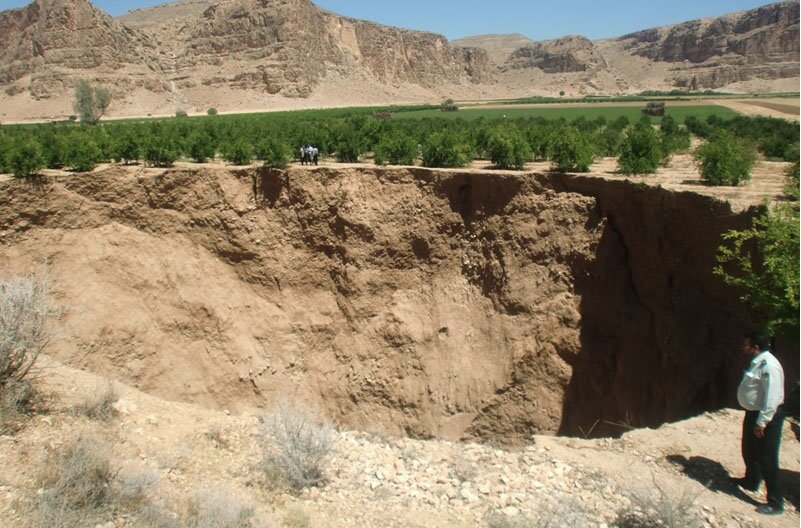‘Silent earthquake’ casts shadow over environment

TEHRAN – Geologists call subsidence a “silent earthquake” because an earthquake is instantaneous and its effects are visible at the same time, but subsidence is the cause of environmental depletion and its impact appears gradually; which is getting a big threat in the country.
Land subsidence, a gradual settling or sudden sinking of the Earth's surface due to subsurface movement of earth materials is mainly caused by aquifer-system compaction, drainage, and decomposition of organic soils, underground mining, oil and gas extraction, hydro compaction, natural compaction, sinkholes, and thawing permafrost.
Subsidence results in significant economic losses in the form of structural damage and high maintenance costs. This affects roads and transportation networks, hydraulic infrastructure, sewage systems, buildings, and foundations. The total damage worldwide is estimated at billions of dollars annually.
80% of groundwater resources withdrawn
Iran is greatly affected by the phenomena, Alireza Shahidi, head of Geological Survey and Mineral Exploration told ISNA on Monday.
Some 30 provinces of Iran are struggling with the issue of subsidence, while two densely populated provinces of Tehran and Isfahan are vastly subsiding by 36 and 17 centimeters annually, respectively; becoming increasingly vulnerable to flooding and natural incidents as well as bearing huge infrastructure damage.With the onset of drought in every country, people are more inclined to use water resources and due to limited water resources in Iran, wells are drilled legally and illegally across the country to compensate for the drought, he added.
In the whole world, water resources withdrawal is between 3 to 20 percent, and when it reaches 40 to 60 percent which is considered problematic, and it will be a crisis when exceeding 60-80 percent, Shahidi noted.
“Yet the contribution of groundwater withdrawal to subsidence in Iran is outpacing the world, withdrawing over 80 percent,” he further noted.
Highlighting that aquifer-system depletion intensifies land subsidence, he said that subsidence is called a “silent earthquake” by geologists because earthquake occurs instantly and its effects immediately appear, while subsidence occurs when aquifers, plants, animals, and human societies have already been damaged.
How aquifer overexploitation can sink lands?
Over the past decades, some of the aquifer levels dropped by 100 centimeters.
On top of that, groundwater drawdowns result in the filling of vacant cavities between soil particles and highly compressible soils which diminishes the capacity of aquifers and increases subsidence probability.
Groundwater overexploitation will affect the plains, as rainwater will not penetrate into the subsurface reservoirs and cause high rates of soil erosion along with permanent inundation.
Inefficient irrigation methods in addition to digging illegal wells are the other main causes of groundwater extraction-induced subsidence, as out of 50,000 wells pumping underground water resources in the capital, 30,000 are illegal.
Almost all provinces struggling with subsidence
Except for Gilan province, all 30 provinces of the country are struggling with the issue of subsidence, which, fortunately, in Isfahan province, more measures are taken to deal with the crisis, he noted.
Two densely populated provinces of Tehran and Isfahan are vastly subsiding by 36 and 17 centimeters annually, respectively; consequently, become increasingly vulnerable to flooding and natural incidents as well as bearing huge infrastructure damage, he explained.
While statistics show that 4 mm of subsidence is referred to as a crisis in the EU, he added.
He went on to state that drought causes people to migrate from the south to the northern cities and depopulate large parts of the country, which will bring up security crises for the country.
Rising temperature, the rising tendency for more water resources
It should be noted that over the next 40 years, the country's temperature will rise by 2.6 degrees on Celsius Scale, which will increase the country's need for more water resources.
Out of 608 plains in Iran, more than 300 are vastly sinking and forbidden to enter, he said.
According to Shahidi, by 2100, due to climate change and melting glaciers, the southern coast of Iran in the provinces of Khuzestan, Bushehr, and Hormozgan will be submerged.
How to reduce the risk?
The installation of smart meter systems on the water pumps and wells is an efficient measure in this regard.
The Ministry of Energy should take steps toward reducing groundwater exploitation, in addition to banning well construction as well as shutting down the illegal wells in the sinking provinces.
It should also control agricultural products and prohibit the cultivation of water-consuming products in those provinces, and instead, introducing agricultural products which require a low amount of water.
The Ministry of Agriculture should cooperate to implement watershed management projects in order to increase the storage capacity of aquifers.
The Department of Environment is another responsible organization that must take more serious steps toward environmental assessment of land subsidence and its prevention techniques.
FB/MG

Leave a Comment